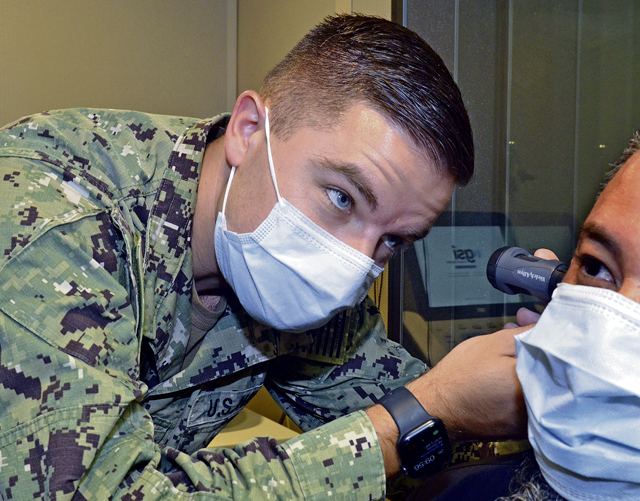
The Defense Health Agency’s Hearing Center of Excellence Military Hearing Conservation Reportopens Hearing Center of Excellence for fiscal year 2021 revealed that hearing loss in the Department of Defense remains relatively stable among service members and civilians enrolled in hearing conservation programs.
The report showed the percent of hearing-impaired service members increased slightly from 14.5 percent in fiscal year 2020 to 14.7 percent in FY21. Civilians saw a gradual decrease from 46.1 percent in FY13 to 42.2 percent in FY21.
According to Dr. Theresa Schulz, HCE prevention section chief, active duty service members have the lowest rates of hearing impairment in FY21 (13.3 percent) compared to the Reserve (18.0 percent) and National Guard (17.4 percent).
“Overall, hearing health in the DOD appears to be relatively stable for service members and civilians in hearing conservation programs from FY20-FY21,” explained Schulz. “The evidence suggests a trend of a marginal increase in hearing impairment for all service members combined and for active duty service members when FY21 data is compared to FY20,” she said.
The report also indicated that the number of unique hearing tests completed by DOD in FY21 decreased slightly for active duty and National Guard when compared to FY20 data; however, the Reserve and DOD civilian hearing tests increased in FY21 compared to FY20, explained Schulz.
“This overall DOD decrease in hearing tests may be due to limited access to hearing health services because of COVID-19 pandemic restrictions,” said Schulz. “During the pandemic, DOD was limited in its use of traditional audiometry (hearing tests conducted in audiometric test booths) by infection control measures due to social distancing, increased cleaning/sanitizing requirements, and compliance with Centers for Disease Control and Prevention guidance regarding room air exchange requirements. For example, air exchange requirements within a booth can increase the time interval between testing personnel that significantly impacts patient flow and timely access to care for clinical and hearing conservation hearing testing.”
Another contributing factor to the slight increase in hearing impairment could also be military accessions data. The report indicates the percent of enlisted accessions with hearing impairments increased in FY21 to 11.2 percent compared to 9.7 percent in FY20. “Reserve enlisted accessions have the lowest rates of hearing impairment at 9.9 percent compared to active duty at 11.6 percent and National Guard at 10.5 percent,” said Schulz.
Reducing hearing loss is a centerpiece of DOD’s policy to protect military personnel and noise-exposed civilians from hearing impairment caused by occupational and operational noise exposure through a continuous, effective, and comprehensive hearing conservation program. The policy also strives to reduce hazardous occupational and operational noise exposure to enhance mission readiness, communication, and safety.
“Those enrolled in a hearing conservation program get annual hearing tests, hearing protection fittings, and hearing conservation education sessions to reduce noise-induced hearing loss, according to HCE’s Branch Chief U.S. Air Force Col. Samuel Spear. “These educational sessions are important touch-points for achieving hearing readiness,” he said. “Hearing readiness is a process to ensure service members have the necessary hearing capability and properly fitted hearing protection devices for mission readiness and deployment.”
Spear noted several efforts are underway across the service components to reduce noise-induced hearing loss.
One significant action on the horizon is a new DOD policy that will soon require hearing protector fit testing to be conducted on all DOD personnel who are exposed to certain noise levels.
According to Schulz, HCE is leading efforts requiring hearing protector fit testing to help mitigate the risk of over exposure to hazardous noise.
“Hearing protector fit testing measures the amount of noise reduction, or attenuation, a hearing protector provides while it is being worn,” explained Schulz. “Among many advantages, fit testing can identify workers at risk for noise-induced hearing loss due to inadequate hearing device fit, help personnel select the right device for their work environment, train workers to properly fit and use hearing protectors, and reduce noise-induced hearing loss for service members enrolled in hearing conservation programs.”
Seeing a change in hearing impairment data could take some time, Schulz noted. The upcoming FY22 hearing health report consequently may not show a vast improvement over the current report. “Changes in these high-level metrics can take years because these lagging measures lack the ability to measure short-term changes, but we are closely monitoring,” she added.
Although these measures of effectiveness are lagging measures, they do summarize the overall hearing health of the force including the civilian workforce, Schulz pointed out.
“We are always exploring ways to improve our hearing loss prevention efforts at the DOD, service, and individual levels. This includes efforts to better monitor, protect, and educate — the three components of HCE’s Comprehensive Hearing Health Program,” said Schulz.


